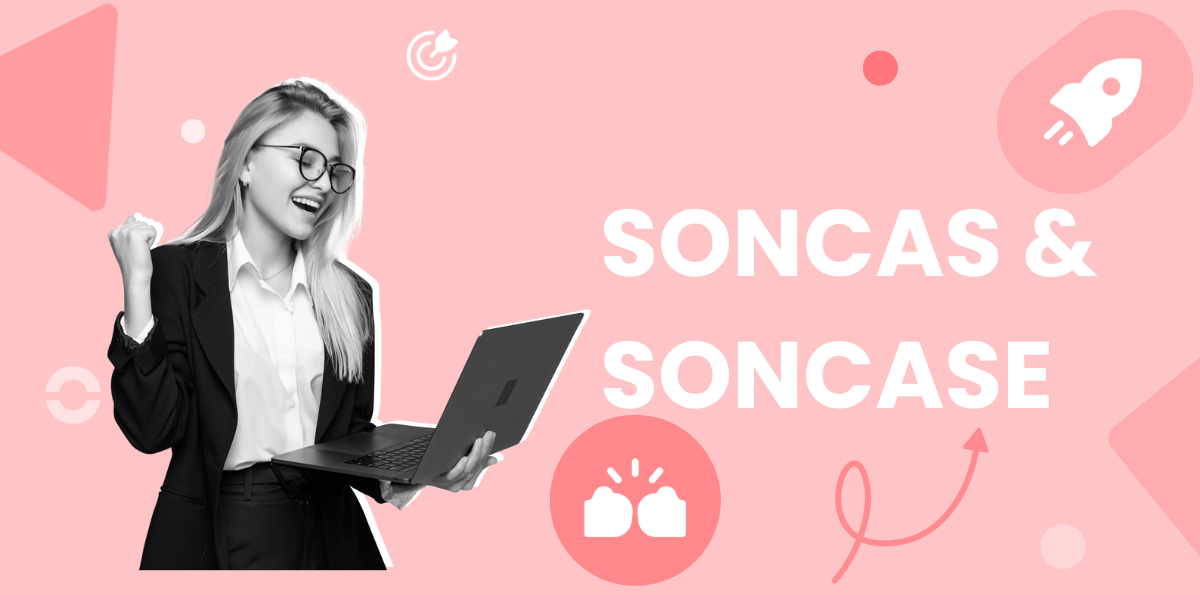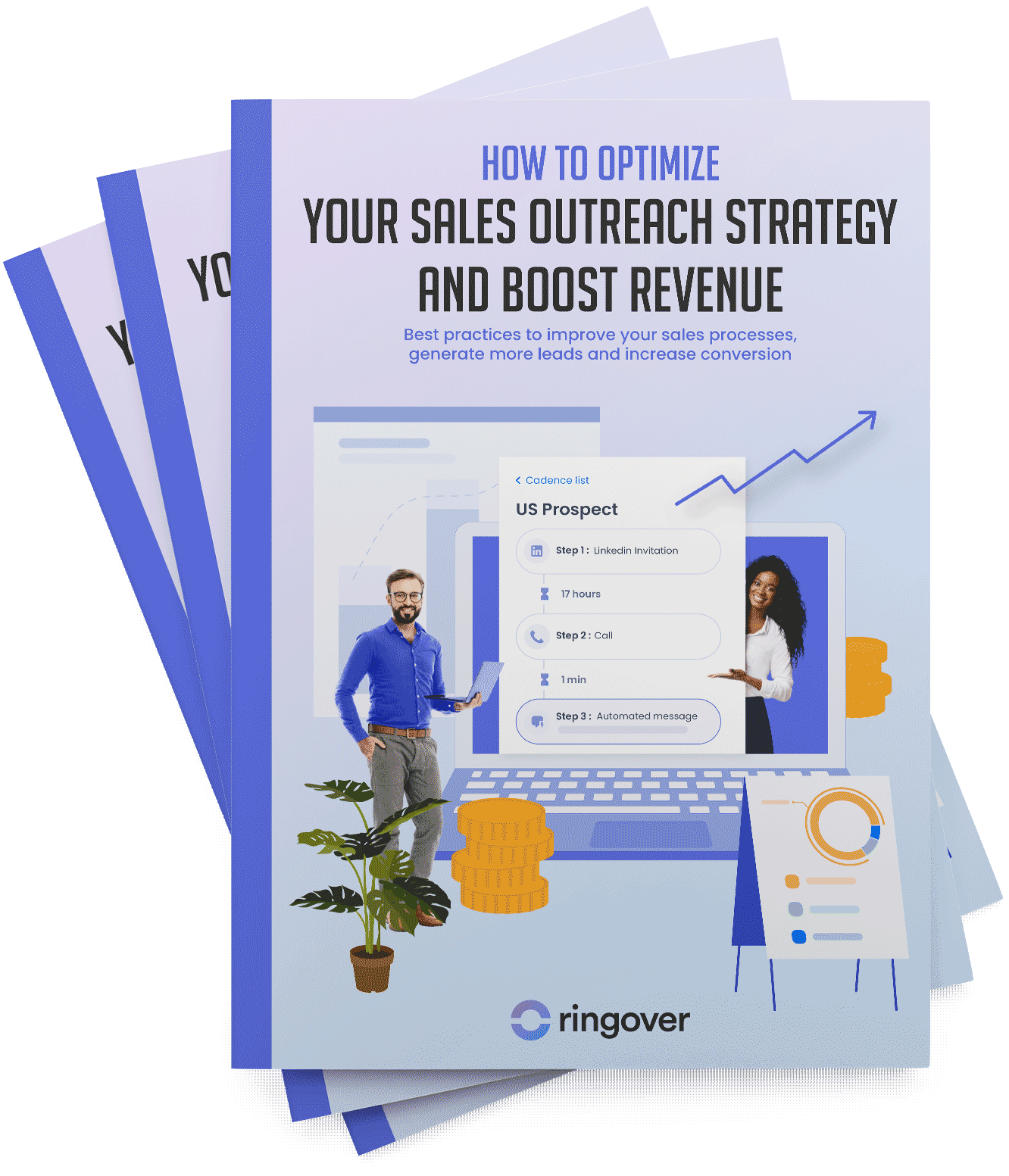Summary
SONCAS and SONCASE are influential sales techniques rooted in psychological principles, aimed at understanding and addressing the diverse motivations driving consumer behavior.
Optimize Your Prospecting With SONCASSONCAS or SONCASE Method: Defined
Created by Frenchman Jean-Denis Larradet, SONCAS stands for sécurité (security), orgueil (self-esteem), nouveauté (novelty), confort (convenience), argent (price), sympathie (affinity)–and écologie (environment) has lately been added to the list.
To recap, SONCASE in English is: security, self-esteem, novelty, convenience, price, affinity, and environmental concerns. These factors represent key emotional triggers that influence purchasing decisions.
By identifying the psychological profile of your prospect, you can offer the most convincing arguments to persuade them to choose your product or service.
The SONCASE method is inspired by Maslow's hierarchy of needs and aims to prioritize the needs of the interlocutor to personalize the discourse according to the buyer persona.
This traditional sales approach remains relevant in today's digital landscape, where marketing automation sometimes risks reducing the personal aspect of the customer relationship.
The SONCAS method allows personalizing this relationship, enhancing the effectiveness of the salesperson by focusing on the specific expectations of the prospect. It is useful both in B2B and B2C contexts.
Using a personalized sales pitch naturally fosters the prospect's purchase decision, thus improving the company's conversion rate. Adding environment as a key factor reflects the growing ecological concern of customers, offering a competitive advantage for certain products or services.
A sales prospecting tool like Cadence by Ringover automates aspects of the prospecting process so you can easily execute the SONCAS method and successfully convert prospects.
The Different Levers of the SONCAS Method, or SONCASE
The SONCAS method is based on six psychological levers impacting a client's purchase decision: security, self-esteem, novelty, convenience, price, and affinity.
These levers represent the needs and desires of clients to be identified and satisfied. The newer version, SONCASE, adds environment to address the consumer's ecological awareness.
Let's delve into the function of each lever and its use to refine an effective sales pitch.
Security
Clients seek to minimize risks. Providing concrete evidence of quality, reliability, and guarantee is essential. For example, present them with testimonials, certifications, case studies, demonstrations, or free trials.
Self-esteem
The need for highlighting value and differentiation is strong. Highlight how your product or service will enhance their image, status, or reputation through exclusive benefits, cutting-edge features, or elegant designs. Personalized compliments or recommendations can also be very persuasive.
Novelty
The attraction to innovation motivates many. Position your offer as unique, original, or trendy by highlighting the latest technologies, updates, special offers, or explorations of new uses.
Convenience
Ease and simplicity are daily pursuits. Show how your solution will save time, energy, or space with its ease of use, ergonomics, and after-sales support. Turnkey solutions, support, or payment facilities are notable value-adds.
Price
Sensitivity to cost and optimization of return on investment is predominant. Emphasize the quality-price ratio, durability, and performance of your offer, not forgetting financial incentives such as discounts, loyalty programs, and money-back guarantees.
Affinity
The human factor greatly influences. Focus on communicating the pleasure, well-being, and satisfaction that your product or service brings by recalling your company's values and social commitment. Small gifts, attentions, and surprises strengthen this emotional bond.
Environment
The ecological and social impact of consumption is a growing concern. Highlight the respect for the environment, animals, and humans by your product or service, citing labels, certifications, and commitments. Offer eco-friendly, supportive, or ethical options to appeal to this conscious audience.
SONCASE: How to Effectively Apply It
The effectiveness of the SONCASE method relies on a clear four-step process: discovery, analysis, argumentation, and conclusion.
Each step is designed to understand and influence the psychological levers of the client or prospect according to their specific profile and situation. Let's examine in detail the course of each of these steps.
Discovery
This first phase involves engaging in an open dialogue with the client or prospect. It consists of asking open-ended questions aimed at revealing their needs, expectations, motivations, obstacles, and constraints.
The goal is to gather as much information as possible to understand their psychological profile and identify the relevant SONCASE levers.
Questions about their objectives, problems, priorities, selection criteria, budget, and decision-making process are particularly useful.
Analysis
At this stage, you evaluate the data collected during the discovery phase to determine the dominant SONCASE levers. The goal is to prioritize these levers based on the client's or prospect's reactions and responses.
Using a SONCASE analysis grid can be useful here, allowing you to evaluate each lever from 1 to 5 based on their frequency and intensity of expression.
Argumentation
During this phase, you present your offer, aligning your arguments with the SONCASE levers identified earlier. The idea is to highlight the added value of your product or service by emphasizing the features, benefits, and proofs most likely to meet the needs and desires of the client or prospect.
The CAP-SONCASE method can be employed to associate each feature of the offer with a benefit for the client, supported by concrete proof related to the activated SONCASE lever.
Conversion
This final step aims to motivate the client or prospect to act by applying sales closing techniques aligned with the activated SONCASE levers.
The goal is to overcome the last resistances, reassure, create a sense of urgency or scarcity, and propose an offer that definitively convinces them.
Use closing strategies like the alternative choice, the summary of benefits, the presentation of a guarantee, sharing testimonials, or announcing special promotions for this purpose.
Is CAP-SONCASE More Effective?
To transform a client's or prospect's purchase motivations into a solid sales strategy, it is interesting to master two complementary methods: SONCASE for identifying motivations and CAP for structuring an attractive and persuasive offer.
But what is the CAP sales technique, and how to effectively combine it with the SONCASE method?
What benefits can this alliance bring and what are its limits? In this segment, we will explore these points in detail.
What Is the CAP Sales Technique?
CAP is another strategy originally developed in France. The acronym stands for caractéristiques, avantages, and preuves. In English, CAP translates to features, advantages, and proof.
Here's an in-depth explanation of this sales technique:
- Identify a specific feature of your product or service, defined by an objective, measurable, and verifiable aspect such as the storage capacity of a device, the speed of a service, or the duration of a warranty.
- Relate this feature to a tangible advantage for the client, clearly illustrating the benefit they will gain such as time savings, money savings, increased comfort, or improved security.
- Support this advantage with concrete proof–a customer testimonial, product demonstration, certification, or case study–thus demonstrating its authenticity and dispelling any doubts.
This process transforms technical and generalist communication into a tailor-made proposal, valuing the utility and precisely meeting the client's needs.
Building Your CAP-SONCASE Argument
The creation of an effective sales pitch relies on the harmonious integration of CAP with SONCASE, focusing on the client's psychological motivations revealed during the initial interview. For each identified motivation (SONCASE), it is appropriate to present a corresponding feature, advantage, and proof.
Here are key tips for developing your CAP-SONCASE argument:
- Highlight features that stand out in the market and meet the expectations of the client or prospect.
- Personalize the advantages based on the client's specific desires, using the vocabulary and expressions they used.
- Provide solid and relevant proofs that meet the client's quality standards and level of trust.
- Organize the sales arguments considering the importance of the SONCASE motivations for the client, starting with the most influential ones.
- Vary the proofs used, alternating between rational proofs (numbers, facts) and emotional ones (testimonials, stories).
Example of CAP-SONCASE Argument for a Company Offering a CRM Software for Insurance Brokers:
1. Features
Present the features in a way that captures the client's interest:
"In the insurance sector, efficient customer relationship management is crucial. Brokers must not only track their clients' needs but also manage complex interactions with multiple insurers. A specialized CRM for insurance brokers can transform your way of working, making every interaction smoother and more productive."
2. Advantages
Highlight the CRM's advantages:
"Our CRM software for insurance brokers offers a range of benefits:
- Centralization of customer information
- Automatic tracking of interactions
- Simplified management of contracts and renewals
- Automation of administrative tasks
- Personalized analyses and reports"
3. Proof
Provide concrete proofs:
"Our clients report a 25% increase in productivity and a significant improvement in customer satisfaction after only three months of use. Moreover, our case studies show a 20% reduction in time spent on administrative tasks thanks to automation."
4. Security
Reassure on the software's security:
"Our CRM is equipped with robust security measures, including data encryption and regular backups, ensuring that your sensitive information remains protected against cyber threats."
5. Self-esteem
Appeal to professional pride:
"By using our CRM, you not only keep up with the current technological trend, but you also become a pioneer in the insurance sector. Our solution is designed for leaders who want to stand out for their efficiency and ability to offer exceptional customer service. By adopting our CRM, you show your clients and competitors that you are at the forefront of innovation and professionalism. You affirm your position as a leader and role model in the sector, which strengthens your reputation and attracts more clients who want to work with the best."
6. Novelty
Emphasize innovation:
"Our CRM integrates the latest AI technologies to help you anticipate your clients' needs and proactively personalize your interactions. It's a tool at the cutting edge of innovation."
7. Comfort
Insist on ease of use:
"Our CRM software is designed to be user-friendly and intuitive, allowing you to focus on your core activities without being hampered by technical difficulties. You can easily integrate it into your daily processes and customize it to meet your specific needs."
8. Price
Present the economic advantage:
"Thanks to our CRM, you can optimize your time and resources, resulting in significant savings on operational costs. Moreover, the first three months are free so you can see for yourself the benefits it brings to your business."
9. Affinity
Strengthen the emotional connection:
"Our CRM is designed by experts in the insurance industry who understand your challenges and are committed to offering you a reliable, personalized, and supportive solution. We value our clients and offer ongoing support to ensure your satisfaction."
10. Environment
Highlight environmental considerations:
"Our CRM software is hosted on energy-efficient servers and follows sustainable practices, reducing your carbon footprint while helping you run your business more effectively."
This approach personalizes the sales pitch according to the client's motivations, increasing the chances of a positive response.
The Benefits of CAP-SONCASE
By combining the CAP and SONCASE methods, the sales representative benefits from a solid and structured framework, promoting a more dynamic, coherent, and impactful approach to sales.
The benefits are numerous:
- Better understanding of the client's needs and motivations.
- A clear and convincing sales pitch.
- Reduced objections and resistance.
- Strengthened trust and emotional bond.
- Increased conversion and retention rates.
The Limits of CAP-SONCASE
However, this combination also has its limits:
- It requires good knowledge of the product or service to present convincing arguments.
- It demands time and preparation to collect the necessary information and identify the SONCASE motivations.
- It may not be suitable for clients or prospects with highly technical or specific needs that require in-depth expertise.
- It can be challenging to maintain a balance between rational and emotional arguments.
Despite these limits, the CAP-SONCASE combination remains an effective method to personalize and optimize the sales pitch, improving the sales representative's performance and client satisfaction.
To go further, also consult our article on the best sales techniques. You will find other advice and practical tools like Cadence, our sales prospecting tool that helps you standardize your processes and automate your tasks.
SONCAS FAQ
What does SONCAS stand for in English?
- SONCAS is an acronym used in the field of sales to denote the six main psychological elements influencing clients' purchasing decisions. These factors are:
- Security: The need to feel confident and minimize the risks associated with the purchase.
- Self-esteem: The desire for personal valorization and differentiation from others.
- Novelty: The attraction to innovative and trendy products.
- Convenience: The pursuit of ease, simplicity, and well-being.
- Price: Sensitivity to price and the quality-price ratio.
- Affinity: The importance of the human factor and pleasant relations with the seller.
How to apply SONCAS well?
To effectively apply the SONCAS method in your sales process, follow these steps:
- Discovery: Engage in an open conversation with the client to understand their needs, expectations, and motivations. Ask open-ended questions to obtain detailed information.
- Analysis: Evaluate the information gathered to identify the dominant SONCAS levers in your client. Prioritize these levers based on their importance to the client.
- Argumentation: Present your offer by aligning your arguments with the identified SONCAS levers. Highlight the features, advantages, and proofs that meet the client's specific motivations.
- Conclusion: Use closing techniques adapted to the activated SONCAS levers to encourage the client to make a purchase decision. Reassure, create a sense of urgency or scarcity, and propose an irresistible offer.
How to identify SONCAS?
To identify the relevant SONCAS levers for a client, proceed as follows:
- Ask open-ended questions: Engage in an in-depth discussion to discover the client's concerns, priorities, and motivations. For example, ask what is most important to them when choosing a product or service.
- Listen attentively: Take note of the responses and verbal and non-verbal cues that reveal the client's psychological priorities.
- Analyze the responses: Use a SONCAS analysis grid to evaluate each lever based on the frequency and intensity of the client's expressions. Assign a rating to each lever to better prioritize them.
- Validate your hypotheses: Confirm your conclusions by asking follow-up questions or rephrasing what you have understood to ensure that you have accurately grasped the client's main motivations.



